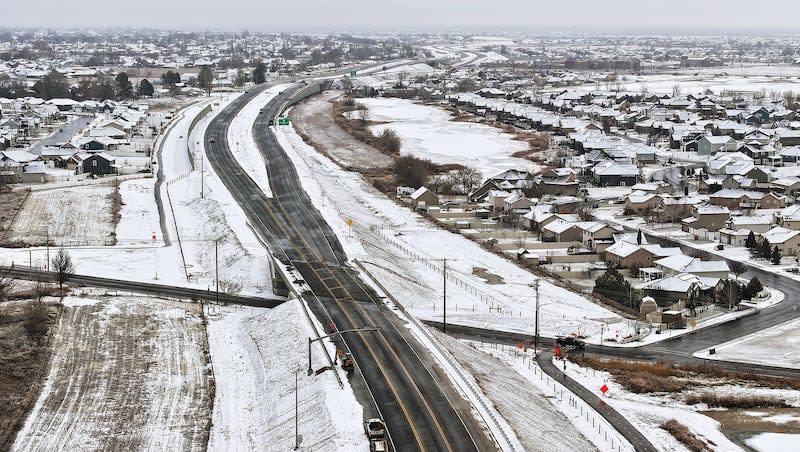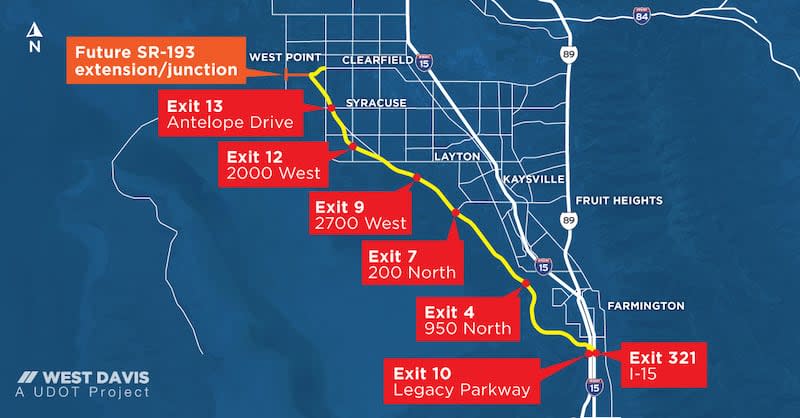West Davis Highway gets high marks after 7 weeks; noise still an issue for some

The West Davis Highway is garnering positive marks from users along the corridor after opening just seven weeks ago, though some issues have emerged as well, including increased noise, at least in some areas.
"For the most part, the new highway has been very well-received by the public," said Utah Department of Transportation spokesman Mitch Shaw. "Much of the feedback has centered around how the road has helped improve quality of life for commuters — shorter commute times, less stress, easier commute."
The new 16-mile corridor, opened to the public on Jan. 6 after about two-and-a-half years of work, traverses western Davis County, extending from West Point south to Farmington and Centerville, where it ties into I-15 and Legacy Parkway. It's a divided, four-lane, limited-access roadway meant in part to ease congestion along I-15, speed north-south traffic flow and accommodate the growing population in Davis County.
Kaysville Mayor Tami Tran noted the speedier connection to the Salt Lake Valley for those in the communities west of I-15 and the new trails and trail connections that are part of the West Davis Highway plans. Going north, the roadway traverses the western edges of Farmington, Kaysville and Layton and cuts into Syracuse and a small section of West Point.

"Kaysville has received positive feedback about the project as residents are becoming comfortable and more familiar with (West Davis Corridor)," she said. Notably, she said, it will help the Wasatch Front "responsibly accommodate future growth."
Syracuse Mayor Dave Maughan noted the scenic view along the roadway, which abuts the Great Salt Lake Shorelands Preserve. "I use it all the time. I love it," he said.
Still, with any project as massive as the West Davis Highway, which has a price tag of some $750 million, there's bound to be criticism — and the West Davis Highway hasn't come without some grumbling. Noise from passing cars is an issue for some who live along the corridor, though UDOT installed noise walls in five sections, three in Syracuse and two at the southern endpoint of the new road section in Centerville.
"That's one of the few complaints we have received about the project," Shaw said. Official traffic counts along the West Davis Corridor won't be released until later, maybe around mid-March, but he said the roadway is getting "solid use."
One area in particular that's been a source of noise complaints, he said, has been the Windmill subdivision in western Layton, around the 3200 West and Gentile Street intersection.
Tran has heard feedback related to noise, mainly remarks from some that the sound of passing traffic is louder than they expected. Farmington city manager Brigham Mellor, too, has gotten feedback about noise, though the West Davis Highway plans have been in the works for so long that those moving to the area, he maintains, should have known what might be in store. "Most of the people who are out there now are resigned to the fact that it is what it is," he said.
UDOT officials have met with neighbors in the Windmill area of Layton, but no new plans are in the works to build a noise wall there or anywhere else along the new highway, according to Shaw. UDOT has detailed parameters that guide noise wall construction, followed ahead of West Davis Highway construction to determine where to place the five noise-reduction structures. The potential impact of a new noise wall in the Windmill area didn't meet the guidelines, in part because it would have benefitted too few homes.
Going forward, Shaw added, UDOT won't build noise walls to buffer new development around the roadway if it occurs in the years to come. "We are not responsible for mitigating noise when a developer comes in and builds homes next to an already existing roadway," he said.
U-turns, signage, lights
Farmington officials had to contend with a unique issue brought on by the placement of exits along the West Davis Highway. The only entry and exit points serving the city are on its southern end where it bumps into northern Centerville, Exit 10, and further north, where Farmington meets Kaysville, Exit 4.
Accordingly, Farmington first responders called to accidents in the northbound lanes of the highway would have to take a circuitous route of 8 to 11 miles via the roadway entry point in the Centerville area, Mellor said. South Davis Metro Fire responders in Centerville would have to travel only about 5 miles, so Farmington reached an accord with the department to assist Farmington in the event of a crash in the northbound West Davis Highway lanes. Farmington officials would be able to respond in time to an accident in the southbound lanes of the new highway.
Long-term plans call for the addition of a new exit between exits 10 and 4, Mellor said, but that could be 10 to 15 years off.
Another unexpected issue has been a rash of people making U-turns across the grassy median dividing the northbound and southbound lanes, Shaw said. Officials deal with cars stuck in the median almost every day, UDOT said in a Facebook post.
"It's very unsafe, not only for the person making the illegal maneuver, but also for the traffic that is moving on the opposite side of the highway," he said. "The speed limit on West Davis is 65 mph, so obviously people are driving at freeway speeds. And they aren't expecting another car to suddenly enter traffic out of the blue."
Beyond safety considerations, traversing the median causes damage and destroys vegetation, necessitating repair and reseeding efforts.
Though the road is open to traffic, final details are still being completed, including installation of some signage and installation of lighting around the West Davis Highway's interchanges. The new illumination will all be "dark-sky lighting," minimizing light pollution.

